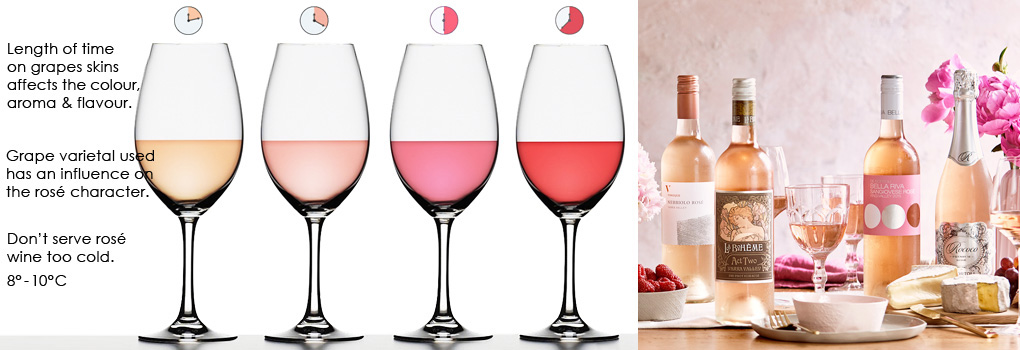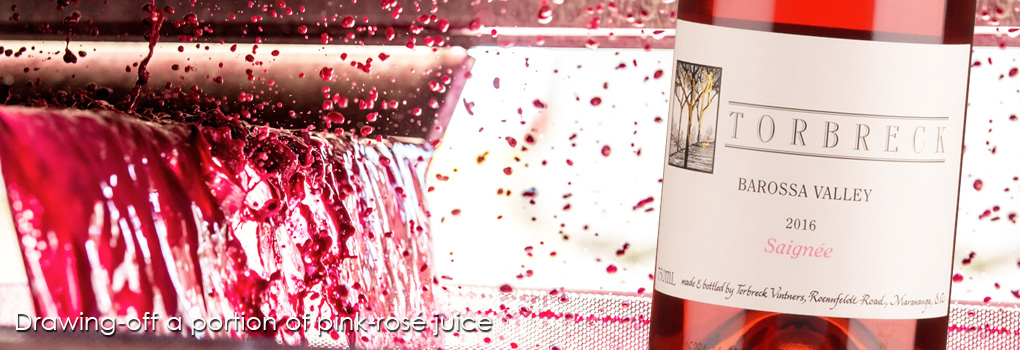How to make Rosé wine:
Rosé wines may and can be produced in a number of different ways, depending on the desired result, personality. The actual-final colour varies depending on the red grape varietal and length of winemaking process used, and often can/ may seem to be more orange in colour than a bright pink or a light red.
❦ Skin-Contact Method:
This is the technique used when a rosé wine is the primary product. Red skinned grapes are crushed and the skins are allowed to remain in contact with the juice for a short period: typically only a few hours (some slightly longer), but there are several now on the market that only took a few minutes of skin contact, depending upon the varietal / mix of red skin grapes used.. The grapes are then pressed, and the skins are removed rather than left in contact throughout fermentation (as with red winemaking).
The skins contain aromas and much of the strongly flavoured tannins and other compounds. The longer that the skins are left in contact with the juice, the more intense the colour and the final character and personality of the wine.
❦ Direct Press Method:
When a winemaker decides to use the Direct Press method to make a rosé - typically a specific grape is grown, harvested and fermented for the sole purpose to produce a rosé. The rosé is not an afterthought or guided by the growing season or ripeness of the grapes. The fruit is often crushed as whole bunches and gently pressed until the juice reaches a desired pale colour.
Direct Pressing involves the grape juice having contact with the skins for an ‘extremely’ short period of time. Instead of allowing the juice time to soak and pick-up colour, the grapes are pressed right away to remove the skins, as a white wine would be vinified. Because of the pigmentation in the red grape skins, there will still be a faint hint of colour in the juice - as it is impossible for the juice to have no contact with the skins.
This method tends to produce the lightest coloured rosé wines. Also the grapes are typically picked at lower brix (sugar levels) to keep the alcohol level lower - which also lifts the natural fruit acidity. This process results in more delicate aromatics, along with defined dynamic notes of strawberries and citrus flavours.
❦ Saignée Method:
Saignée or bleeding, is used when the winemaker desires to impart more tannin and colour to a primary red wine, and removes some pink juice from the 'must' at an early vinification stage (from the press or tank), in a process known as bleeding the vats. The removed juice is then fermented separately, producing the rosé as a by-product of the red wine, which is intensified as a result of the bleeding process, because the volume of juice in the 'must' is reduced and the 'must' involved in the maceration is concentrated.
❦ Blending Method:
In the past, it was fairly common to make rosé wines by simply taking a white wine and adding a bit of red wine to it. Some winemakers thought this could produce interesting wines that possessed some of the original character of a red wine while retaining the crispness of the white wine. This practice has fallen out of fashion; except in the crafting of quality Champagne Rosé where it is a highly respected skill. Where you add a small volume of red wine (typically made from Pinot Noir) to the cuvée before the secondary fermentation inside the bottle. As you are aiming to achieve the same aroma, colour and character in a NV Rosé Champagne every season - this is a highly respected achievement.
Still Rosé wines are very popular in France and Spain, which have ensured the success of several quality makers of rosé wine, and today many wine enthusiasts across the UK, United States, Australia and New Zealand are turning their attention to this vibrant and refreshing wine style.
✱ Flavour Range:
Depending upon the grape varietal, time and the technique used, you can have a flavour range of: pink grapefruit, watermelon, strawberries, raspberries, cranberries to pomegranate, plus combinations of all these and more - enjoy the journey.


Saignée Method:
This winemaking process involves 'bleeding' (drawing-off) a portion of pink-rosé wine after only a short period of time - (a short contact of the juice with the grape skins). Because the colour of red wine is derived from pigments in the grape skins, the resulting juice is a pale, light or bright pink - but not red. This process is how many rosé wines are made, the only exception being Champagne Rosé - where they are typically made by blending red juice, with the main body of white wine before the secondary fermentation inside bottle. Though for still rosé wines some believe that the best wines are made by the saignée method.
The rest of the winemaking process, steps remain basically unchanged in that there is a progression of alcoholic fermentation, filtering, and then bottling all in a short space of time.
The difference between simply macerating the wine and removing the 'must' and saignée - is that the wine left after the bleed-off is often still being made into a more concentrated red wine, and the rosé is a by-product.
So the saignée method can be used by winemakers wishing to increase the intensity in their red wines. In this case, only a small portion of juice is bled away (removed) from the skins to make a rosé. But the remaining juice stays in contact with the skins. Because there is a greater surface area ratio of skins to juice after the bleed, so more colour (and possibly complexity) can be extracted from the skins into the red wine-to-be. As a result, some people refer to rosé made by the saignée process as a by-product of red wine production.
Some top rosé producers, particularly in the south of France, prefer not to 'bleed' their grape juice. Instead, they treat red grapes destined for rosé much as they would grapes for a white wine. After the grapes are harvested, they are crushed and quickly pressed or whole cluster pressed - just as white wine grapes are - directly into the fermenter. In this way, there is little or short skin maceration.
Not surprisingly, wines made in this fashion can be a lighter shade of pink (as the juice has only kissed the skins), but not lighter in character. Enjoy these rosé wines in their youth and served at approximately 8º-10ºC.

